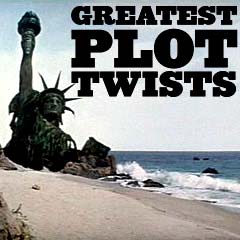
|
|
|
||||||||||||
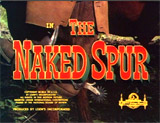
|
The Naked Spur (1953)
Director Anthony Mann's western (his third of five western collaborations with actor James Stewart) was a Technicolored, vengeful bounty-hunter tale with only five acting-speaking roles. In the untamed Colorado Rockies, Howard Kemp (James Stewart), a tormented, brooding and manic anti-hero, was intent on tracking and capturing a wanted murderer and cunning outlaw, Ben Vandergroat (Robert Ryan), and bringing him back to Abilene, Kansas for the advertised bounty of $5,000. With the help of grizzled, luckless prospector Jesse Tate (Millard Mitchell) and dishonorably-discharged, amoral, playboyish and disreputable Union cavalry rider Lt. Roy Anderson (Ralph Meeker), Kemp located and apprehended Ben. The outlaw was found with blonde, short-haired, tomboyish 'traveling companion' Lina Patch (Janet Leigh), the daughter of one of Ben's deceased friends, Frank Patch. In the back-story, Kemp wanted the bounty to repurchase land that he had lost during the Civil War. When he went off to fight for the Union, he trusted his faithless fiancee Mary with the title to his ranch and farmland, but then while he was away, she sold his property and ran off with another fellow. As the group returned to Abilene, they were faced with many dangers and tensions, including greed and distrust among the group of three reward-seekers, and a violent Blackfoot native Indian attack. In the exciting climax set at a raging riverside, Ben had persuaded Jesse to desert the group, and then ruthlessly killed him. Ben was then poised on a high rock face as a sniper with a rifle to ambush Kemp and Roy. Kemp climbed the face of the rocky cliff behind Ben and flung his "naked spur" (used to scale the cliff-face as a axe/piton) into his lower cheek or neck - after which he reeled around and Roy shot him from a distance and finished him off. Ben's corpse fell into the roaring river below. Roy retrieved Ben's body, but then was lethally struck by a gigantic log stump, drowned and was carried downstream. Kemp hauled in Ben's corpse with a rope, and became insanely single-minded and heartless ("I'm takin' him back. This is what I came after and now I've got him. No partners like I started. He's gonna pay for my land... The money - That's all I care about. That's all I've ever cared about") - determined to claim the reward all for himself as he strapped the corpse on his horse. He told Lina: "Maybe I don't fit your ideas of me, but that's the way I am." Lina backed down but still pleaded to leave the whole ordeal behind them:
Then, in an abrupt turn-about, after Lina's offer of marriage, Kemp gave up his potential blood-money bounty, buried Ben's body in the ground, and then rode off with her to start a new life in California together. |
 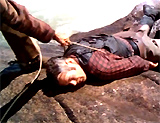 Howard Hauling in Ben's Body 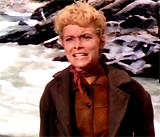 Lina (Janet Leigh) 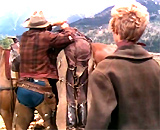 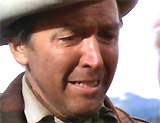 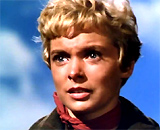 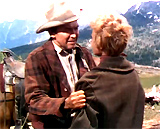 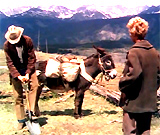 The Decision: To Collect the Bounty, or Bury the Body and Move to California with Lina |
||||||||||
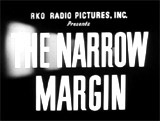
|
The Narrow Margin (1952)
This taut, superb, fast-moving noirish crime-drama from director Richard Fleischer had the tagline: "A Fortune If They Seal Her Lips... A Bullet If They Fail!" The plot was about police engaged in a crack-down on Los Angeles Crime - seen in a headline. The secondary story was titled: "POLICE HUNT MOBSTER FRANKIE NEALL'S 'PAY-OFF LIST'". In other words, a number of mobster assassins were targeting a widowed gun moll and grand jury witness to silence her. She was being transported on a confining, transcontinental cross-country Golden West Limited train from Chicago to Los Angeles, and had vital and crucial information - a purported list of pay-offs - that she was going to divulge at a hearing on the West Coast. In the opening scene, incorruptible hard-boiled Det. Sgt. Walter Brown (Charles McGraw) and Sergeant Gus Forbes (Don Beddoe) took a taxi from the train station to pick up the dislikeable female at her apartment hideout to take her to the train. They discussed what the woman might be like (Brown: "Sixty-cent special. Cheap, flashy. Strictly poison under the gravy.")
She was introduced as feisty Mrs. Frankie Neall (Marie Windsor). As they were coming down the stairs into the apartment's foyer, Forbes was gunned down by mobster assassin Densel (Peter Virgo), identified by a fur-collared coat. On the moving train, where Detective Sgt. Brown was attempting to hide Mrs. Neall in an adjoining sleeper cabin/compartment, two other assassins were circling around trying to locate and kill his subpoened grand jury witness: Joseph Kemp (David Clarke) and Vincent Yost (Peter Brocco)
The detective and ill-tempered Mrs. Neall took an instant disliking to each other: (Brown: "You make me sick to my stomach." Neall: "Well, use your own sink. And let me know when the target practice starts!") Brown became acquainted with another woman on the train - a golden-haired, sweet-natured mother named Ann Sinclair (Jacqueline White) with a precocious, overly observant son Tommy (Gordon Gebert) in tow and an older nanny, Mrs. Troll (Queenie Leonard). He worried that the mobsters might mistake her for his witness and kill her. Gangster Yost unsuccessfully attempted to bribe Brown with $25-30K into giving up his protected witness: "You have her, we want her, how much?...Point her out and turn the other way. You go through the motions of guarding her until the accident occurs." Brown responded: "I'm not interested...not at any price." The detective was warned: "We'll get her whether you give her to us or not, so don't take too long. It would be a shame if you missed your opportunity." Brown was aided by rotund railroad detective/agent Sam Jennings (Paul Maxey) (originally thought to be one of the assassins), who handcuffed gangster Kemp and detained him after Brown beat him up. However, at a train stop in La Junta, Colorado, Densel (Peter Virgo) surreptitiously boarded the coach, traded places with Yost, freed Kemp, and knocked Jennings unconscious. The two mobsters discovered Mrs. Neall in Brown's attached cabin, and as she reached for a gun in her purse, Densel shot her in the back. It was then revealed in a surprising character/identity twist that Mrs. Frankie Neall was actually a decoy -- a policewoman from Internal Affairs named Sarah Maggs. Brown's loyalties were being tested by the DA via the decoy Mrs. Neall to see if he would accept the bribes offered by the hitmen to give up his witness (Ann Sinclair: "It's an investigation into grafts and payoffs, remember?"). Ann described how she had found her divorced mobster husband's payoff list, and already mailed it to the DA. Brown reacted vehemently: "I've been played for a sucker!" And then, Mrs. Sinclair was seized and held hostage by Densel, and Brown used the reflection of another train's window to gun him down without compromising her safety. Kemp fled and departed from the back of the train, but a few minutes later was arrested as he was about to be picked up by a getaway vehicle that had been trailing the train for many miles. In the conclusion, Brown safely escorted Mrs. Sinclair off the train. |
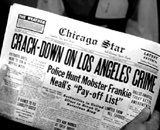 The Pay-Off List 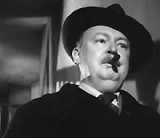 Sgt. Gus Forbes (Don Beddoe) Just Before Being Murdered 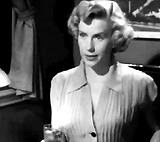 Mrs. Ann Sinclair (Jacqueline White) - The Real Grand Jury Witness 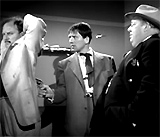 (l to r): Kemp, Brown, and Jennings 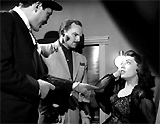 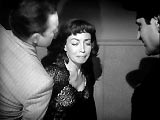 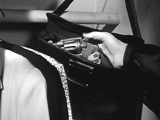 Mrs. Neill Seized - Reaching for Her Gun and Then Shot In the Back 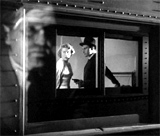 Protecting The Real Witness - Mrs. Sinclair by Shooting Densel, Using A Window Reflection |
||||||||||

|
Never Let Me Go (2010, UK/US)
Director Mark Romanek's haunted, somber and melancholy romantic drama was really a dystopic, sci-fi horror story. It was based on the downbeat and dark 2005 novel by Kazuo Ishiguro, and slightly borrowed from the sci-fi cult films Logan's Run (1976), Parts: The Clonus Horror (1979), and Michael Bay's The Island (2005). The futuristic, dramatic sci-fi tale was set in pastoral England - an alternate universe. Society had evolved and rid itself of diseases and illnesses. After a medical breakthrough in 1952, the average life expectancy had advanced to over 100 years by 1967. The film covered a period from 1978 to 1994. Told in prosaic narrative flashbacks by tragic, deeply-emotional student Kathy (Isobel Meikle-Small as youth, Carey Mulligan as teen), she had first been a young sheltered attendee at a mysterious, rustic, yet idyllic British boarding school called Hailsham. Teachers were referred to as "guardians" without reference to parents. Kathy's best friends at Hailsham in the late 1970s, involved in an ill-fated love triangle, were:
Ruth eventually stole Tommy's heart. However, Kathy kept her unrequited love for Tommy alive, one day hoping that Ruth and he would separate. The plot twist or main theme was unveiled slowly, although it was basically telescoped very early on, during the preface (a quick flash-forward to the film's grim conclusion). Kathy narrated as the film began, as she looked through a hospital's pane of glass on an impending operation - for an organ donation!
In addition, about twenty minutes into the film, new guardian Miss Lucy (Sally Hawkins) lectured to one class of unaware fourth-year Hailsham students that they would never grow up. (Her unauthorized, subversive revelation caused her to be removed shortly thereafter by the headmistress.) Body parts were to be harvested from the students - they were being bred specially as human clones (the word "clone" wasn't used). The children were being raised to provide vital organ "donations" to prolong the lives of others, thus leading to their own deaths:
In 1985, about a half-hour into the film, the three school grads (at around age 18) had departed from Hailsham for a halfway house, the farm-like environment of the Cottages, where they were allowed to grow up and await their doomed fates. Curiously, none of the doomed or exploited teens attempted to escape or rebel, but accepted their fates and destinies calmly. At age 19, Kathy applied to be a Carer to supportively facilitate the passage of others who underwent successive organ-donor operations at Completion (death) centers, in exchange for a temporary reprieve. She left the Cottages at about the same time that Tommy and Ruth split up, as their long-time threesome unraveled. In 1994 at Completion, Kathy (who shuttled from hospital to hospital across the country) came upon Ruth almost ten years later. Ruth was close to death or completion after her second organ removal operation. They journeyed together to meet up with Tommy, who had also had two operations and was recuperating at the Kingsfield Recovery Centre. During their short visit, Ruth apologized to them for having kept them apart from sharing their real love: "Should have been you two together, I always knew it." She proposed that they apply for a deferral of Completion, after proving to the authorities that they qualified - that they were verifiably and truly in love. Kathy and Tommy further explored and enlivened their love for each other when she became his Carer. After Ruth Completed (died) during another operation, the two went to see if they could defer their own Completion for a few years. They were shocked to hear that "there are no deferrals. And there never have been," told to them by Halisham's former art Gallery Madame (Nathalie Richard), and Halisham's ex-Headmistress Miss Emily (Charlotte Rampling). The two were described as "poor creatures" who were beyond help. Kathy's voice-over words ended the heart-wrenching film, as she witnessed Tommy's final operation behind a glass pane before dying - and her own organ donations would begin in a month. In the countryside, she remembered their younger and happier days, and was resigned to her own fate: "We all complete":
|
 Hailsham Student Kathy (Carey Mulligan) 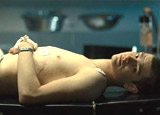 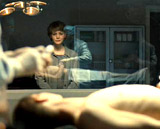 Friend Tommy's (Andrew Garfield) Final Donation of Organs 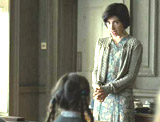 School at Hailsham: Teacher Miss Lucy (Sally Hawkins) - Lecture to Class About Never Growing Old  (l to r): Kathy, Tommy, Ruth 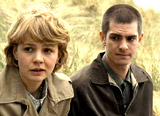 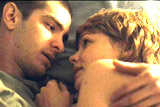 Tommy and Kathy in Love 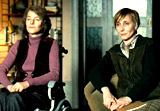 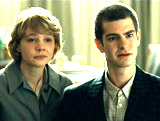 The Bad News: There Were No Deferrals From Completion 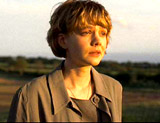 Final Scene |
||||||||||
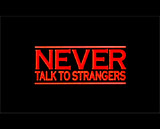
|
Never Talk to Strangers (1995)
In director Peter Hall's psycho-sexual erotic thriller (similar in part to The Silence of the Lambs (1991) and Basic Instinct (1992)), the main character was another brilliant, cool blonde - a criminal psychologist named Dr. Sarah Taylor (Rebecca DeMornay). As part of her job, she was evaluating the sanity of accused serial killer Max Cheski (Harry Dean Stanton). In the meantime, she fell in love with smooth talking, quick-tempered, passionate, long-haired Latino stranger Tony Ramirez (Antonio Banderas) who she said was "a bad influence." In Tony's "loft" apartment where walls were composed of wire fencing and wooden cages, she found vigorous, kinky thrills with him inside one of the 'caged' or mesh-screened rooms. It appeared that she was being disturbingly stalked with both strange gifts and death threats:
When Sarah looked into Tony's background, he was revealed to be a police officer and surveillance expert. (She didn't know that Tony was investigating the strange, unsolved disappearance of Benny Martin, Sarah's ex-fiancee a year earlier.) In the nail-biting conclusion set in Sarah's house, Tony confronted her and pulled a gun on her. She accused him of stalking her ("I've seen the file, Tony. I know you've been stalking me right from the beginning") and he confirmed that he had been investigating her. He told her that he had installed a surveillance camera in her hallway to help identify her stalker. It was revealed that she was actually stalking herself and sending herself frightening and strange objects: ("It's you, Sarah, you've been stalking yourself"). Tony demonstrated that Sarah had multiple personality disorder, and he advised: "You need help." Then, her ailing estranged father Henry (Len Cariou) entered the house, someone Sarah feared. Her illness stemmed from an abusive childhood from her despised father Henry during which time she murdered her mother to satisfy Henry and cover up the crime. Sarah flashbacked to her abusive childhood about 20 years earlier, when her despised father (who had committed incest with her) was confronted by her mother Alison (Susan Coyne). She knew of his sexual abuse ("You'll never, ever touch that child again!"). Alison threatened to leave, causing Henry to erupt in a rage and push her down the stairs, while young Sarah (Emma Corosky) watched. Henry then coerced his daughter to help cover-up the crime to ensure that Henry wouldn't be blamed, by shooting her (with his help) and calling it an accident: "Mama's been bad and gotten Daddy in trouble. You have to help Daddy pull the trigger. Do as you're told. One, two, three. All right. All right. Daddy'll help you."
Knowing the truth of what happened to her mother so long ago, Sarah aimed her gun at her father, claiming: "It wasn't an accident, was it? You put the gun in my hand." Sarah described the effect her father's abuse had on her: " You think I don't remember what happened, what you did to me every night? You think I don't remember the sound of your shoes, coming into my bedroom every night? Why they took me away from you? Why my aunt would never let me see you? You fooled everybody. You never fooled me." When Tony asked her to trust him and he disarmed himself, she shot him to death. She had now revealed the man-hating, homicidal alter-ego side of her multiple personality disorder (MPD). She screamed at Tony as he died on the floor, and kicked his body: "Now you know what happened to Benny. You were so f--kin' interested. He was a worthless piece of s--t, like you. Like all men. Like all men!"
Then, she screamed at her father, in an unholy voice: "F--k! Now look what you've gone and done! And I'm gonna have to f--kin' cover for you again! Goddamn it! I'm sick of it!" When her father assured her, as he had done many years earlier, "It wasn't your fault," she picked up Tony's gun and killed her father with multiple gunshots. She said to herself: "It never happened. Never happened like that. Never happened. I'm not gonna remember any of this. All right, Sarah. It's gonna be all right. It was self-defense." Then, she easily convinced the police that the crazed Tony murdered her father and that she killed Tony with her own gun in self-defense. She signed a statement about what happened:
Two detectives discussed the likelihood that Sarah probably wouldn't have to stand trial. Six months later in her psychiatry office, Sarah was preparing and recording an upcoming convention lecture about a "very interesting disorder" - MPD - a disease she didn't know she suffered from: "Multiple Personality Disorder cannot easily be faked. Witness the case of recently-convicted serial killer Max Cheski who tried to use it as the basis of his defense. The creation of multiple personalities can always be traced back to childhood trauma often involving violent sexual abuse. Subconsciously, the child creates other personalities that share the burden, the literally unbearable burden of shame underlying the repressed memory of the childhood events. These personalities often turn against their creator, sometimes inflicting actual bodily harm." Her pushy next-door neighbor Cliff Raddison (Dennis Miller), with whom she had experienced a one-night stand earlier, entered her office for an 8 o'clock movie date. |
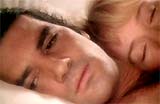 Tony Ramirez (Antonio Banderas) and Dr. Sarah Taylor (Rebecca DeMornay)  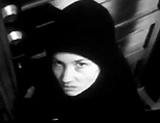 Surveillance Footage (Tony: "You've Been Stalking Yourself") 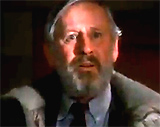 Sarah's Father Henry 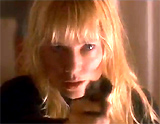 Sarah Holding Her Father at Gunpoint 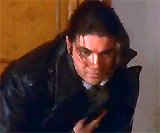 Sarah's Murder of Tony 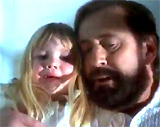 Sarah's Recollection and Flashback to Henry's Words: "It Wasn't Your Fault" 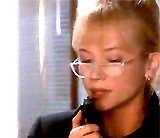 Sarah Recording Her Lecture About MPD 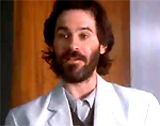 Cliff Raddison (Dennis Miller): Sarah's Next Man |
||||||||||

|
Next (2007)
New Zealand director Lee Tamahori's sci-fi suspense thriller was reportedly based on another Philip K. Dick short story from 1954, The Golden Man, although there was very little resemblance between the two. The film suffered from a lack of believability, and an unfair and unsatisfying 'pull-the-rug out from under you' twist. It contained a gimmicky premise summarized in the film's tagline:
Two bit Las Vegas magician/"mentalist" Cris Johnson (stage-named Frank Cadillac) (Nicolas Cage) at the Back Page had a gift - or curse. He could see two minutes into his own future - a useful gift when applied to gambling at blackjack. In voice-over, he described the implications of his complex ability (that could change the future), just before he was able to thwart a heist in the casino:
He was pursued by tough, insistent and intense FBI Special Agent Callie Ferris (Julianne Moore) to help the agency, with his precognitive "definable ability" and "advanced awareness." They needed to locate a stolen, 10 kiloton nuclear munition smuggled into the US by a Russian Federation. It was about to be detonated in the greater Los Angeles area by terrorists led by arrogant Mr. Smith (Thomas Kretschmann), who knew about the clairvoyance of "carnival barker" Cris Johnson. The agents (and the terrorists) were always a step behind locating Cris - who could outmaneuver and evade them - but how could a two-minute warning, in any scenario, help to prevent the bomb's deployment and a major catastrophe? A romantic subplot involved Cris and repeated cryptic sightings of a visionary girl - part-time Havasupai Reservation teacher Elizabeth "Liz" Cooper (Jessica Biel). He had foreseen meeting her at 8:09 am in a cafe-diner many times, where they finally met and became acquainted - after he made multiple attempts to select the right circumstances. After a visit to the reservation, the road was washed out and they were forced to spend the night together at the Cliffhanger Motel outside Flagstaff. They had sex the following morning - at 45 minutes into the 96 minute film. After sex, there was a lengthy pull-back from a close-up of Cris' opened eye, when he awoke in the motel bed with Liz, while staring at the ceiling. The film continued, with the plot of Cris trying to evade the terrorists (who wanted to kill him), and the FBI (who wanted him to lead them to the terrorists). He told Liz about his unique capabilities of seeing two minutes into his own future, but that she was unusual to him. It was different with her - he could see much further with her:
He attempted to reassure her that it wasn't a set-up. After diverting the FBI (and allowing himself to be caught) so that Liz could escape, she was unfortunately abducted, taken as a hostage, and strapped to a wheelchair with explosives by the international terror syndicate at the site of the detonation - a parking garage roof. At the end of all of the action within a large warehouse, Liz was saved by Cris, but he mistakenly detonated the nuclear device and Los Angeles was destroyed ("I made a mistake. It's happening... Now!"). And then the film's plot twist was revealed - almost at the very end of the film - it was another variation of the "it was all a dream, vision or illusion" twist. The explosion had not actually occurred. After the dreamed catastrophe of the future, the scene returned to a closeup of Cris' eye popping open, as he laid in the Cliffhanger Motel bed with Liz, staring at the ceiling again after having sex. Everything that had occurred up to that point was his envisioning of everything that could happen leading up to the nuclear explosion. As the film ended, he called Callie, and agreed to cooperate and help the FBI ("I'll do it, but I have conditions. I want her left out of it"). He told Liz that there was something he had to do that couldn't be put off any longer. He asked her to wait for him for a week or maybe a month during his mission to prevent the nuclear disaster ("If you can wait, I'll find you"), and then kissed her. He stepped into Callie's FBI van outside their motel, as he repeated - in voice-over:
|
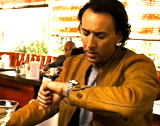 Cris Johnson (Nicolas Cage)  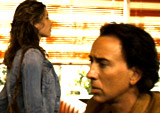 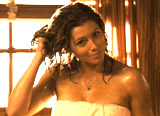 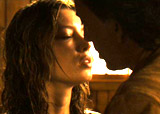 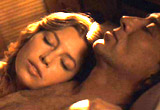 With Elizabeth "Liz" Cooper (Jessica Biel) 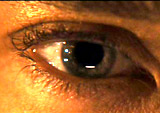 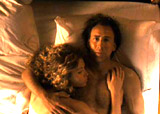 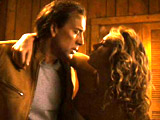
At the Cliffhanger Motel |
||||||||||
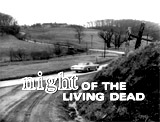
|
Night of the Living Dead (1968)
Director George A. Romero's low-budget, independent horror film was a landmark zombie film about a gruesome night of death in rural Western Pennsylvania in the fight against an army of undead. In the simple yet brutally relentless plot of claustrophobic horror, the 'living dead' (re-animated corpses) mysteriously rose from the grave. One explanation by a radio reporter was that a returning space probe from Venus was deliberately exploded in the atmosphere by the military when it was detected that it was radioactively contaminated - and the fall-out had infected a wide area of the US. Crazed mass murder was occurring in many locations. A group of seven strangers were forced to take refuge from the shuffling, hungry, flesh-eating zombies in an isolated Pennsylvania farmhouse. A capable and smart black man named Ben (Duane Jones) assumed leadership as the army of corpses repeatedly tried to enter the house during a terrifying siege, amidst both unspoken racial and generational tensions between him and a less capable, older white family man. One by one, the inhabitants of the farmhouse were infected by bites or died in other ways, and became flesh-eating, re-animated zombies themselves:
By the end of the film, there was only one person who remained: strong-willed black protagonist Ben, who had survived the night in the farmhouse basement. There were only a few ways to 'kill' a zombie permanently - a gunshot or heavy blow to the brain, or by burning them. Posses or mobs of armed rednecks were in the countryside attempting to restore order. The tragic ending came from the actions of real mindless zombies -- living lynch mobs. In the morning, Ben was distressingly and shockingly shot in the head by a member of a vigilante mob when he peered out of a broken window in the living room of the farmhouse. He was mistaken for one of the living dead. Afterwards, his body was thrown into a pile of ghoul corpses and set on fire. |
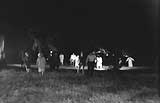 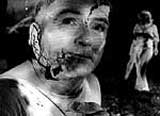 Zombie Siege  Cannibalistic Karen 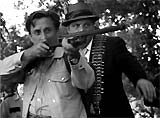 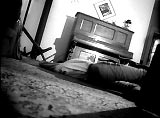 Ben's Dead Body on the Floor 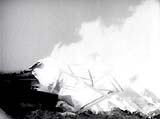 The Burning Pile of Corpses |
||||||||||

|
A Nightmare on Elm Street (1984)
Writer/director Wes Craven's slasher film was about the town of Springwood, Ohio, where teens on Elm Street were stalked by a demonic, psychopathic dream killer named Freddy Krueger (Robert Englund). The iconic Freddy wore a fedora, a dirty red/green striped sweater, had a disfigured and scarred face, and sported a glove with 4 razor-sharp claws for fingers. The reason for the vengeful stalkings, in the teens' dreams, wasn't entirely clear, but occurred in the past. Later in the film, it was revealed that Freddy was the victim of vigilante justice, when angry parents in the community (after the killer was released from custody because of a minor technicality) burned the child murderer to death in a boiler room. Years later, the children whose parents were responsible for Krueger's death were being terrorized. The main teen characters were:
During the film's proceedings, Freddy killed all of Nancy's friends, and almost killed her as well:
In the ambiguous, tacked-on, twist-ending epilogue (it appeared that everything that had occurred earlier was a dream, now followed by another dream??), all of the teens were now alive. Teenager Nancy exited her mother Marge's (Ronee Blakley) bedroom after vanquishing the demonic dream killer. She found herself outside her front door in the bright but diffuse morning fog. Her mother saw her off and vowed to stop drinking. She was picked up for school by her friends, no longer deceased, in Glen's convertible in front of her house. As the car roof tightly clamped shut over their heads, it revealed itself as red/green striped (the colors of Freddy's sweater). Uncontrollably, the windows rolled up and the car drove off, with the frightened and kidnapped kids trapped inside. Oblivious to their entrapment, Marge waved goodbye, as the camera panned to the right where a group of white-dressed young girls were jumping rope and singing the Freddy rhyme. Suddenly, Freddy's right arm smashed through the front door's small window and grabbed Marge - and pulled her entire body through the opening. |
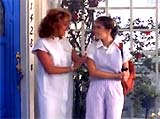 Marge (Ronee Blakley) With Daughter Nancy (Heather Langenkamp) 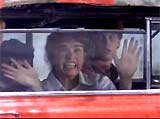 Nancy and Teens Trapped in Car 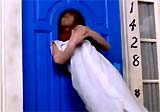 Freddy's Arm Grabbing Marge 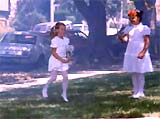 Girls Jumping Rope |
||||||||||
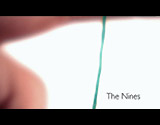
|
The Nines (2007)
Writer/director John August's independent psychological thriller (his directorial debut and a semi-autobiographical work), a confusing science-fiction mystery-fantasy, was described by its tagline:
The ingenious, "puzzle pieces" episodic mind-bender was composed of three intertwining stories with the same actors/actresses (in addition to Ryan Reynolds, also Hope Davis, Melissa McCarthy, and Elle Fanning) - all interlocked and linked by the number 9.
The main theme of the disorienting, metaphysical film was shifting identities (similar to Charlie Kaufman's Adaptation (2002)). Nin9r "G"'s three main created characters (all played by Ryan Reynolds), were Gary (an actor), Gavin (a writer), and Gabriel (a game designer). They were all alternate identities in alternate realities. In Part One - "The Prisoner," troubled but popular TV actor Gary Banks (Ryan Reynolds), from the crime-fighting TV series "Crime Lab" (a CSI knock-off) was introduced as he purchased crack cocaine, solicited an overweight streetwalker (Octavia Spencer), partied in a motel room, and experienced hallucinations (he thought he didn't have a belly-button and asked: "Am I alive?"). During a crack-aided joyride, he saw visions of two other future incarnations of himself (the film's major plot point!) in the backseat of his car - Gavin and Gabriel - but he disregarded them. After rolling his car upside down in downtown Hollywood, he was charged with crack use and arson (he had burned down his own house after breaking up with his girlfriend), and jailed. He was bailed out by his chubby publicist Margaret (Melissa McCarthy), and kept sequestered (under house arrest) in a writer's house who was away in Canada on a shoot. Although she was supportive, she was tough-minded and threatened him (as Kathy Bates did in Misery (1990)):
The vain, sexy actor began to experience multiple occurrences of the number 9: the area code for take-out food delivery, two paintings (of a 7 and 2), the name of his TV series rewritten as "CRIM9 LAB," an orange Post-It note in the kitchen in his own handwriting ("Look for the NINES"), backgammon dice rolls, and newspaper real estate ads, etc. His desperately flirtatious next-door neighbor, single mom Sarah (Hope Davis), often came to share drinks. When he left the house on one occasion, he was haunted by a mute girl Noelle (Elle Fanning) with cryptic hand signals before being returned by the police to the house and fitted with an ankle bracelet, after which Margaret moved in to be his protective baby-sitter. When Gary mentioned: "There's something wrong with the world," Sarah suggested: "I can get you out of here but you have to trust me." When Gary asked Margaret about the "nines," she explained: "They're subconscious, trying to remind you who you are." He asked: "I'm a nine?" to which she responded, "Yes. It doesn't make much sense out of context." Margaret admitted that she had known him for 25 years, although not always as 'Gary.' She added: "You're not who you think you are." She also warned about Sarah, whom she called a "Nine." When Gary stepped over a red chalk boundary line ("the edge of your world") - he violated his house arrest barrier, and everything disappeared in an atomic flash of white light. In Part Two - "Reality Television," a hot-shot, gay TV show screenwriter and workaholic Gavin Taylor (Ryan Reynolds) had just successfully pitched a pilot for a one-hour crime-show thriller (a series titled "Knowing," aka "Rosemary's Toddler") to the VP of Drama Development, Susan Howard (Hope Davis). During the film shoot, an additional "Behind the Screen" reality show ('behind the scenes') was being created (with handheld digital video cameras), to include Gavin's adventures as the thriller's creator/showrunner - Gavin was trailed around by a reality TV show crew. Susan was pressuring Gavin to sever his ties with and fire his best friend Melissa McCarthy (Melissa McCarthy), who was married to Ben Falcone. She was Gavin's first choice for lead actress (the character of "Mary") - he wanted to recast the role to improve ratings. Gavin was the writer/creator of "Crime Lab," and owned the house where Gary had been held under arrest (Gavin was on the pilot's six-week shoot). He had also left the note: "Look for the Nines" (referring to the most important individuals in ratings focus groups). Stressed about his situation, Gavin resorted to his addiction to online role-playing games ("You lose yourself a little bit in them. I love that it's a different world that's existing at the same time. They're better than real life. If you get stuck, you can always hit reset"). He also felt as if his identity's boundaries were breaking down:
He confessed to Melissa that she was being replaced in the show, adding: "I really want this show on the air. I have all of these characters inside of my head, and they want to live, and I'm the only way that they can...I have five seasons mapped out." And then, Melissa's replacement actress became unavailable, something Susan had known from the start. She warned him about Melissa: "I had to get you away from her. She was holding you back. You had to give her up." The reality show about Gavin would be the only offering in the new TV schedule. After an angered Gavin punched Susan in the mouth, she revealed his true identity: "Is that all there is? Do you feel like a man? Because, I'll tell you a little secret. You're not." At the end of Part Two, Gavin found himself on a street-corner telling his film crew to disappear - ranting and talking to himself, until everyone completely disappeared.
And in Part Three - "Knowing," the title of the pilot reality show episode itself, earnest, bearded father Gabriel (Ryan Reynolds), a successful video game designer, was now married to editor Mary (Melissa McCarthy) with an 8 year-old daughter named Noelle (Elle Fanning). Stranded while in the Southern California woods/mountains with a dead car battery, he abandoned his family to seek help. Gabriel hiked to find a cell phone signal when he met up with mysterious and suspicious 'flower-child' hitch-hiker Sierra (Hope Davis). While waiting in the car, Noelle watched a video on Gabriel's digital camera, showing segments of the previous two parts (Gavin apologizing to Melissa in Part Two, and Margaret talking to Gary in Part One). Sierra agreed to drive Gabriel to seek help, but then led him in circles and drugged his water supply, to make him intoxicated. Sierra revealed she had come to perform an intervention on the main "G" male character. Throughout the entire film, as Sarah and Susan (and now Sierra), she had been attempting to separate the three incarnations of "G" from Mary, and get "G" to stop his addiction to creating unreal identities, and limited and corrupted worlds, and to return home. The intervention came in words spoken by Mary to her third "G" husband Gabriel - she accused him of forgetting who he was by reincarnating into so many different roles:
After returning home with his family, Gabriel (or "G") admitted to Mary that he liked his created world - "I like this world. I like my life here with you and Noelle." She replied:
He responded that there were 90 different variations of the universe and this was his last one - he had destroyed "billions of people" with his thoughts. After telling her that she was his "favorite," he ripped the green thread bracelet around his wrist - and the false universe dissolved around him. [Twist Ending and Revelation: The big reveal, vaguely explained, was mostly a let-down. The three "G" characters, Gary, Gavin, and Gabriel were all imagined incarnations. As the film ended, Nin9r "G" chose to stop creating worlds and identities, and returned home (by the act of removing his bracelet). The at-peace housewife - the same character from all three acts (Melissa McCarthy) - was happy to be leading an idyllic married family life with caring husband Ben and daughter Noelle (the same name of characters in Part Two). Noelle assured her mother: "He's not coming back. This is going to be OK. He put all the pieces together. It's like..." She interrupted: "the best of all possible worlds."] |
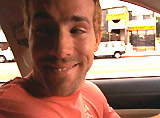 Actor Gary Banks (Ryan Reynolds) 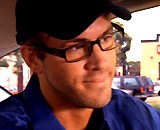 Writer Gavin Taylor (Ryan Reynolds) 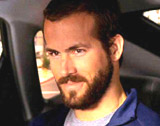 Game Designer Gabriel (Ryan Reynolds) 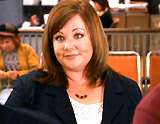 Margaret (Melissa McCarthy) 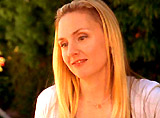 Sarah (Hope Davis) 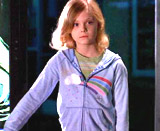 Noelle (Elle Fanning) 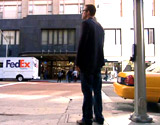 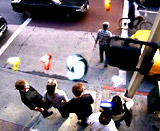 Gavin on Street Corner with Rating of Nine Twirling Above His Head  Gabriel with Sierra in Part Three 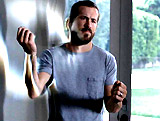 The End to Imaginary Worlds: Removing the Bracelet  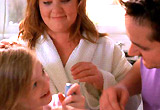 Housewife "Mary" Married to Ben in The Final Scene |
||||||||||
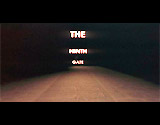
|
The Ninth Gate (1999)
Director Roman Polanski co-wrote the screenplay for this neo-noirish, sometimes plodding gothic mystery thriller, with themes of double-cross, supernatural devil worship, and a trail of murder. Unscrupulous, self-interested, mercenary NYC rare book dealer Dean Corso (Johnny Depp) (who was quoted as saying: "I believe in my percentage") was hired by wealthy book collector, publisher and witchcraft-demonology expert Boris Balkan (Frank Langella) of Balkan Press to authenticate or validate his recently-purchased copy of a rare 17th century (1666) book on demonology, The Nine Gates of the Kingdom of Shadows -- a "supreme masterpiece." The book was authored by writer Aristide Torchia (AT), who was burned at the stake during the Inquisition. Corso, with eyeglasses and a goatee, was to travel (all-expenses paid) to Europe to track down two other existing copies. They were privately owned in two different locations:
Corso was to discover which of the three copies was genuine:
Nine engravings in the pentacle-emblazoned book -- correctly interpreted and spoken out loud, would according to legend reportedly "conjure up the Prince of Darkness" - Lucifer (LCF) himself, the book's reputed co-author. Presumably, Balkan wanted the authentic book so he could ritualistically summon Lucifer through the Ninth Gate. Corso suspected that Balkan had already failed once to raise the devil ("You mean the devil won't show up"). Before leaving for Europe, the first contact of the shady "mercenary" Corso was Liana Telfer (Lena Olin), the conniving sultry, gold-digging femme fatale widow of Andrew Telfer (Willy Holt) who originally owned the book (bought in Toledo-Spain) and had sold it to Balkan. She failed to reacquire the book from the "book detective" when she appeared at his NY apartment door, proposed an orchestrated theft, and then offered herself as a "bonus" - she seduced him by feeling his crotch and then 'f--ked' him, but failed to acquire the tome. She angrily bit his chest and knocked him unconscious with a liquor bottle. Corso had temporarily entrusted the book to his NY business partner Bernie Ornstein (James Russo) for safe-keeping, while traveling. He found Ornstein murdered - hanged from his left ankle and made to appear like the 6th engraving in the book. Enticed by more money from Balkan, Corso flew to Europe - to Toledo, Spain - to the bookstore of twin Cineza brothers who had sold the book to Telfer (at his wife's insistence), and learned that the initials LCF on three of the engravings referred to Lucifer (the book's "illustrious collaborator"), the other six to AT (the author). As he traveled by train to Portugal, he found himself again pursued (actually assisted and protected) by a mysterious and enigmatic 'guardian angel' figure named The Girl (Emmanuelle Seigner) - nicknamed "Green Eyes," who appeared in various situations (always wearing jeans, jogging shoes and mismatched red and green socks). She helped him navigate through the perils of his search, including saving him twice from harm inflicted by Liana's blonde-haired, black bodyguard (Tony Amoni). It was in Portugal at the home of Victor Fargas (Jack Taylor) who owned a second copy, that Corso discovered three of the nine engravings (# 2, # 4, and # 6) were attributed to LCF - slightly different from Balkan's copy (only # 3, # 8, and # 9 were attributed to LCF, while all the others were attributed to AT). As it turned out, three different engravings in each book ("all three copies are genuine") varied from those in the other two books - Corso surmised an important plot point:
In Paris, he learned from stump-handed, wheel-chaired Baroness Frieda Kessler (Barbara Jefford) about the Order of the Silver Serpent (member Liana Telfer's left buttocks was tattooed with its coiled serpent icon). The Order was a secret society ("a kind of witches coven"), dedicated to worshipping the Prince of Darkness, that had degenerated into a "social club for bored millionaires and celebrities who use its meetings as an excuse to indulge their jaded sexual appetites." The Baroness had long since dropped out ("My orgy days are over"), although members still met annually on the anniversary of Torchia's death. In the Baroness' copy, as expected, # 1, # 5, and # 7 were attributed to LCF. Liana ("the Telfer woman") stole Corso's copy (Balkan's book) from his Parisian hotel room, and was pursued to her gated St. Martin chateau where she was about to lead a Satanist Order occult ceremony (similar to Kubrick's Eyes Wide Shut (1999)), dressed in a black robe and reading from the book. She became the fifth victim associated with the book, when suddenly attacked by Balkan who called her a "charlatan." The trail was littered with death - those who owned (or were associated with) copies of the book ended up dead:
Caught in the floorboards, Corso witnessed as Balkan, believing that he was invincible and immune to flames, self-immolated during the Satan-summoning ritual. When he managed to get free, Corso mercifully put him to death with a gunshot. Afterwards, Corso succumbed to the sexual temptations of the hypnotic green-eyed Girl as the castle/tower continued to burn down behind them. And he also became obsessed with finding the diabolical Ninth Gate - a passageway to reach hell. She told him the "game" was not over for him. The 9th engraving was a forgery - the reason for Balkan's failure. She then hinted with a clue (a note on the car's windshield: the fake 9th engraving had the words "CENIZA BROS." scrawled in red across it) to the location of the authentic 9th engraving (she looked like the naked demoness riding a seven-headed dragon in the ninth illustration). Corso found the real engraving on top of a dusty bookcase being dismantled in the abandoned Spanish bookshop owned by the twin brothers. The film's final image was of Corso crossing the threshold with the nine engravings (including the authentic 9th one) - departing through the ninth gate into an 8-pointed blaze of light at the castle. One way to help interpret the film was to discern the cryptic puzzle ("Satanic riddle") hidden inside the nine illustrations, by using a combination of the "LCF" versions of each of the nine engravings distributed across all three copies of the book. (the original engravings were signed with initials AT (Aristide Torchia), while the 3 changed ones in each book were labeled with the initials LCF (Lucifer))
Differences between the AT and LCF engravings: 1 - a castle with 4 turrets (AT), or 3 turrets (LCF) |
 Boris Balkan (Frank Langella) 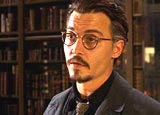 Dean Corso (Johnny Depp) 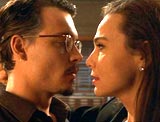 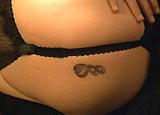 Corso with Liana Telfer (Lena Olin) - With Tattoo  The Girl (Emmanuelle Seigner) 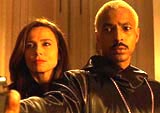 Liana Telfer and Bodyguard (Tony Amoni) 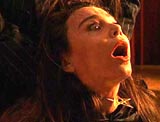 The Death of Liana Telfer - Killed by Balkan 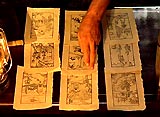 The Nine Pages of the Book 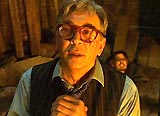 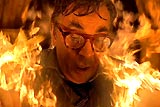 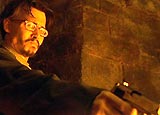 The Fiery Death of Balkan Due to the Wrong Incantation 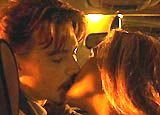 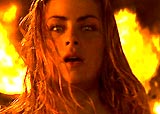 The Sexual Temptations of The Girl 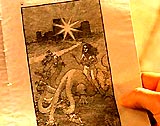 The Authentic 9th Page Engraving 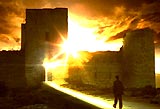 Entering the Ninth Gate |
||||||||||

|
No Way Out (1987)
Director Roger Donaldson's suspenseful political thriller was a remake of director John Farrow's noirish The Big Clock (1948), starring Ray Milland and Charles Laughton. The film's tagline was:
The main story line was about naval attache Lt. Cmdr. Tom Farrell (Kevin Costner), who was posted at the Pentagon. He reported directly to Secretary of Defense David Brice (Gene Hackman). When he began an affair with high-class mistress-escort Susan Atwell (Sean Young) - he was not aware that she was his superior's mistress. Not revealed until later what his motivations were, Farrell was gathering intelligence from Atwell (since she was also Brice's mistress) when she shockingly turned up dead. It was revealed that Atwell's murder was committed during a jealous rage by the suspicious Brice who brutally slapped Susan Atwell when questioning her about another lover - and accidentally killed her. When he struck her after she called him a "pig," she toppled backwards from her upstairs balcony onto a glass dining room table on the first floor. Farrell was innocent of the murder, but became involved when Brice instigated a top-secret cover-up, and Farrell was assigned to find the killer. Brice's own ruthless General Counsel Scott Pritchard (Will Patton) described the scandalous problem:
With Pritchard's advice, Brice blamed the crime on a bogus, never-seen Russian KGB mole/spy code-named "Yuri." (Little did they know that Atwell's other lover was actually a KGB spy.) Throughout the film, Farrell, who was assigned to investigate the DC murder, furiously raced against time to find blame elsewhere during an investigation that might have falsely implicated him as Atwell's killer (because Farrell had also had a sexual relationship with Atwell), and exposed his real identity. He only had a few hours to name the killer before a Polaroid negative found at Atwell's place could place him there and make him a suspect. The major twist was that Farrell, while innocent of the murder, was the KGB sleeper agent named 'Yuri' who had infiltrated the Pentagon. [In effect, Farrell was investigating himself!] Farrell successfully exposed Brice as the actual killer (he proved Brice's involvement with a computer printout, showing a government-registered gift of a 'gold jewelry box' given by Brice to Atwell). In the meantime, Pritchard wanted to pin the murder on Farrell, coincidentally deducing that Farrell was Yuri!:
Pritchard then boldy asserted: "You have no idea what men of power can do." When Brice shifted the blame to his Counsel Scott Pritchard, naming him as the spy Yuri (arguing that homosexual Pritchard was jealous of his relationship with Susan), Pritchard committed suicide by shooting himself in the head in his office - and was falsely exposed as "Yuri" - the KGB spy. Farrell also implicated Brice in the murder. The entire film, revealed at the end, was told as a flashback during Farrell's debriefing at a safehouse with his Soviet superiors who had commissioned him to seduce Atwell in order to blackmail Brice. His bosses criticized Farrell for his "poorly-handled" relationship with Atwell. Farrell argued back: "I did what I was told! You wanted me to be her lover. I was her lover." A Soviet official spoke to Farrell (Russian name: Yevgeny Alexeyevich) - in Russian, seen in English subtitles: "Couldn't you have managed this better?" Farrell was told that it wasn't possible for him to remain in the US, and that he must return to Russia:
But Farrell was reluctant: "I came here. I thought I owed you that. But you can't make me go back." After telling them that he was ready to quit being "Yuri," Farrell was allowed to leave, although one of the officials stated that he would be back:
The film concluded with a claustrophobic spy satellite-view of Farrell/Yuri getting into his car and driving off. |
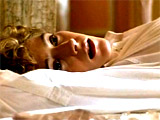 The Death of Susan Atwell (Sean Young)  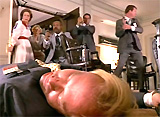 Pritchard's (Will Patton) Suicide 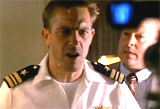 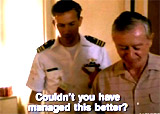  Lt. Cmdr. Farrell (Kevin Costner) with Soviet Officials 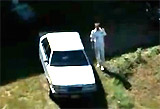 Last Image |
||||||||||

|
Director Alfred Hitchcock's adventure thriller was about mistaken identity. Innocent businessman Roger Thornhill (Cary Grant) had been mistaken for a non-existent government spy/agent named George Kaplan. Thornhill soon found himself on the run (and framed for a murder he didn't commit of UN diplomat Lester Townsend (Philip Ober)) from foreign spy Philip Vandamm (James Mason) and his henchman Leonard (Martin Landau), and the FBI. The spies were involved in a scheme to smuggle highly-sensitive government-secrets microfilm out of the country (hidden in an art statue). During Thornhill's flight in a north by northwest direction, via 20th Century Limited train bound for Chicago, he became acquainted with beautiful but mysterious blonde Eve Kendall (Eva Marie Saint), who helped him to evade the authorities, although she was working together with Vandamm and Leonard. About midway into the film, the spy named 'George Kaplan' was revealed to be a fictional US agent. This was explained in a long expositionary dialogue by the Professor (Leo G. Carroll) in a room full of agents:
The Professor was aware that Thornhill had been mistaken for a non-existent agent, who had been created as a decoy to protect the identity of a genuine agent in the employ of the CIA - double-agent Eve Kendall! Roger had become the useful decoy named Kaplan and there was nothing that could be done to protect Thornhill directly. In the film's conclusion set at Mount Rushmore in South Dakota, Thornhill rescued Kendall from being eliminated (the spies had determined that Kendall was a government agent), and the two found themselves clinging for their lives from the famed tourist attraction, as Leonard was shot and Vandamm was captured. |
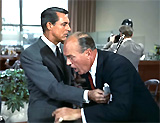 Roger Thornhill (Cary Grant) Implicated in Death of Lester Townsend (Philip Ober) 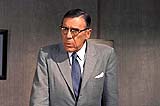 The Professor (Leo G. Carroll) 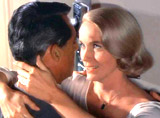 Eve Kendall (Eva Marie Saint) with Thornhill 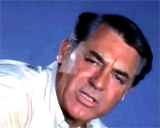 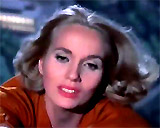 Hanging on Mount Rushmore |
||||||||||

|
The Notebook (2004)
This beloved romantic drama from director Nick Cassavetes was the story of two lovers, who met one evening as teens at a carnival on Seabrook Island, SC, in the 1940s:
Their story was a narrated flashback read from a "notebook" by one nursing home patient to another:
The two teens were unable to consummate their relationship due to their different social classes and interference from her parents. Allie's parents, especially Allie's mother Ann (Joan Allen), disapproved and Allie was moved away to Charleston, SC. During World War II, Allie was being courted by Lon Hammond, Jr. (James Marsden), a handsome and wealthy lawyer, and he became her fiancee, but she was indecisive about marrying him. After the war, Allie visited Noah one idyllic afternoon and went rowboating through a spectacular duck-filled setting, when she learned for the first time that he had written her 365 love letters (one each day for a year) - although her domineering mother had intercepted them and disapproved of his 'low-class' status. Noah professed his love on the dock during rain-soaked kisses: "It wasn't over. It still isn't over!" Eventually, she left Lon, returned to the abandoned 200 year-old house in Seabrook Island, SC, which Noah had fixed up and restored (and was living in) - and built to her specifications, and moved in with him. "Duke" often read to Allie from a "notebook" about the two young lovers, titled: "The Story of Our Lives." It could be readily guessed and gradually revealed, the film's plot twist, that they were the lovers being referenced in the notebook. It was written by Allie as a present to Noah years earlier, with the handwritten dedication in the front:
Noah would repeatedly attempt to rekindle their love by re-reading from her old faded notebook diary. It was shown that Allie could only remember the story of their love for a few minutes. After one of the readings telling of their love for each other, Allie briefly remembered their love during a special candlelight dinner in the nursing home when they shared a dance together - Allie requested: "Do you think I can be her tonight?" - but then she rapidly 'forgot' and panicked. In the final scene in the rest home, she remembered him as they held hands in her bedroom, where he promised he would always be there and never leave her. She asked him: "Do you think that our love can create miracles?" He replied: "Yes, I do. That's what brings you back to me each time." She asked a second question. "Do you think our love can take us away together?" He responded: "I think our love can do anything we want it to." They fell asleep in Allie's nursing home bed, and passed away together by morning.
|
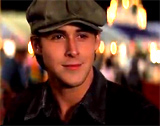 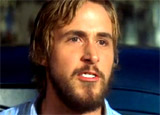 Noah Calhoun (Ryan Gosling) 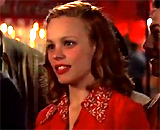  Allie Hamilton (Rachel McAdams)  "Duke" (James Garner) and Allie (Gena Rowlands)  The Candlelight Dance 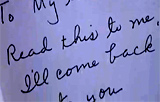 The Notebook's Handwritten Dedication |
||||||||||

|
Nothing (2003, Can.)
Writer/director Vincenzo Natali's low-budget, trivial black fantasy-comedy (similar to his plot-twisting, puzzling sci-fi film Cube (1997)) was unique in that it was an existential, illogical morality play with basically two characters within a white void. The wildly inventive experiment in CGI seemed inspired in part by George Lucas' THX 1138 (1971). Its tagline described its plotline: "What if you wished everyone - and everything - would just go away!" The film's main characters were two 30-something losers: they were odd-couple room-mates (friends since 9 years of age and co-dependent friends) and social outcasts who lived in Andrew's inherited, dilapidated house (condemned by the city of Toronto) between two highway overpasses:
The two friends realized that they had the power to wish away their troubles - when at 3 pm, their house was surrounded by authorities to arrest them and by wreckers to demolish the home. When they screamed out: "Leave us alone!", their entire outer world disappeared, replaced with white nihility. The two opened the door to blinding white light enveloping their house. They still had oxygen to breathe, and gravity to hold them down, and they could walk/bounce on the featureless surface (similar to "tofu"). The two explored the 'nothing' void of emptiness around them for a few days, and then circled back and came upon their house - within their finite world. The two enjoyed thinking about their new world:
Eventually, they figured out that they both had god-like powers that could mutually wish away things they hated - both external and internal. It began with the elimination of various objects: a noisy clock (or time), a stack of overdue bills, and their hunger (they had run out of food). Their ability to cause things to vanish extended to their disagreeable or self-destructive memories (sometimes accompanied by the sound effect of a tape rewinding). Andrew sought a path of self-improvement and reform (he began jogging for the first time, and was reading The Science of Tao), while Dave sought hedonistic pleasures (being lazy, playing his drums and video games, etc.). Inevitably, and comically, the arguing roommates hatefully turned their powers on each other in a battle of destructive wills (i.e., Andrew eliminated Dave's guitar, while Dave caused Andrew's favorite video game controller to disappear; they each wished away their two beds and other furniture). Soon, they were also wishing away the entire house and their own body parts (feet, legs and torsos), until they were reduced to two disembodied heads, bouncing in the void. They eventually apologized for their bad behavior (Dave's abandonment of Andrew by moving out to be with his girlfriend, and Andrew's neediness), and declared they had been very good for each other. They raced toward a far-off point in the whitish unknown, followed by their turtle Stan. After the end credits in the film's coda, ten years had passed and the two heads (now aged with long hair and beards) were still alive. They were awakened from slumber in the void by a crashing sound, and then stampeding, trumpeting elephants and a horse neighing. They screamed as the film abruptly ended. |
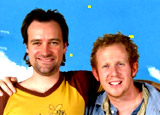 Dave and Andrew  Their House Between Highway Ramps  The White Nihilistic Nothingness   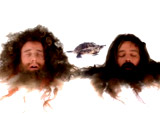
|
||||||||||
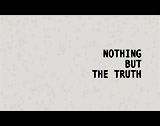
|
Nothing But the Truth (2008)
Writer/director Rod Lurie's intelligent and suspenseful political thriller was very loosely inspired by the so-called 2005 Valerie Plame affair, when NY Times reporter/journalist Judith Miller was jailed for 85 days for refusing to testify before a grand jury and reveal her government source who outed the CIA covert agent, Valerie Plame. This disguised straight-to-DVD docu-drama opened with a disclaimer about how it was only "a fictional film." Due to the bankruptcy of the film's distributor, the film was never given a wide theatrical release, except for its openings in New York and Los Angeles. The film started with the embarrassing causal event - a US presidential assassination attempt that was blamed on Venezuela. The US president ignored a CIA report (leaked by an unidentified CIA secret agent after a fact-finding mission) that Venezuelan involvement was non-existent, and proceeded with an unjustified, retributory US missile strike on Venezuelan military bases three weeks later. A news reporter issued a news story which outed the agent as the source of the report (thus ruining her undercover occupation). The two major female characters were both soccer moms, with children at the same DC school, Potomac Shores:
Rachel opted for maintaining her confidentiality, rather than revealing her top-secret original source that blew the cover on Van Doren - a CIA NOC (non-official cover). News reports stated the President's attack was "the worst foreign policy decision in this nation's history." Although supported by her editor Bonnie Benjamin (Angela Bassett) and the paper's legal counsel Avril Aaronson (Noah Wyle), Rachel immediately found herself menaced and intimidated by the FBI, while Erica was intensely badgered by her CIA handlers. In the film's most talked about line of dialogue, Erica chastized and warned Rachel: "You are an unpatriotic little cunt who's gonna walk right off the plank into the bowels of hell. Do you know that?" There was a continuing tense stand-off between:
Rachel's contempt of court case (for refusing to reveal her source) immediately landed her in jail, where she languished for almost a year. In the jailyard, she learned of her Pulitzer nomination as a finalist. Both Rachel and Van Doren struggled to defend the rights of free citizens to proclaim the truth over authoritarian government pressure (arguing for "national security"). Van Doren expressed the misogynistic sexism of her case to her own boss (Michael O'Neil) at the agency, arguing that she wasn't to blame:
In the same vein, Rachel fought her side of the argument to Burnside:
A few major twists or surprise revelations were learned by film's end:
|
 Reporter Rachel Armstrong (Kate Beckinsale)  CIA Covert Agent Erica Van Doren (Vera Farmiga) 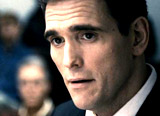 Patton Dubois (Matt Dillon) 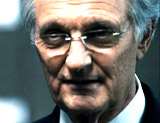 Albert Burnside (Alan Alda) 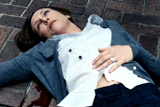 Death of Erica 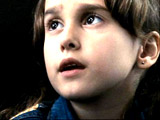 The "Original Source" Allison Van Doren (Kristen Bough) |
||||||||||

|
November (2004)
This low-budget, indie film shot on digital video from director/editor Greg Harrison was a supernatural (or psychological) thriller. It had a very gimmicky, pseudo-clever twist that was completely revealed about 30 minutes into its short 73 minute running time. One line spoken by Officer Roberts (Nick Offerman) about blurry photographs also applied to the entire film:
The derivative twist was that the protagonist went into denial after a traumatic event, and was believing or experiencing things that weren't true - this was the same plot bender in so many other films:
To top it off, the entire 'surprise' ending was completely foreshadowed in the film's opening shaky montage - specifically with three images that appeared before the credits. The film was most noted for its journey through the various stages of dying, chronicled in a book written about by Elisabeth Kubler-Ross, where complete refutation finally became complete acceptance. The plot was divided into three parts, each simply labeled with white-on-black title cards:
The film's tagline was: "The Truth Lies Outside the Frame," recalling what the protagonist told her photography students - apt words for her own perspective on her life - and death, and for the edited film itself:
NOV 07: Hugh (James LeGros), the attorney live-in boyfriend of photographer-teacher Sophie Jacobs (Courteney Cox) was shot unexpectedly during a convenience-store robbery by a solitary white male Shooter (Matthew Carey) at Lolo's Market in mid-town LA, on Friday, November 7th. The couple had stopped there to buy chocolate after having dinner at a Chinese restaurant. Grief-stricken and depressed over her feelings resulting from the killing, Sophie's sanity began to disintegrate as a result of the trauma, and she experienced debilitating headaches. In conversations with her psychiatrist Dr. Fayn (Nora Dunn) a month later, she admitted that she had been cheating on Hugh with co-worker Jesse (Michael Ealy) - it was thought that guilt over her affair might be the cause of her condition. Shifting narrative replays of recent events, recollections and thoughts in Sophie's mind were occurring, although it was evident that she was avoiding the realization of what had really happened on the night of November 7th. Various scenarios were played out:
Her last moments (the film's content) were her memories as she lay dying on the floor next to Hugh. Police, paramedics, and a photographer entered the store to confront the gruesome and bloody aftermath. |
 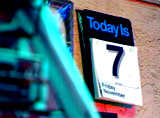 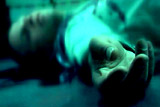 Three Images Before Credits 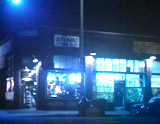 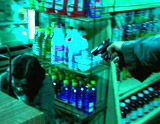 The November 7th Convenience Store Robbery and Shooting 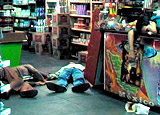 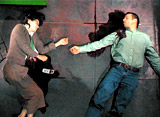 Both Hugh and Sophie Were Killed in the Robbery |
||||||||||
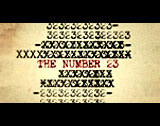
|
The Number 23 (2007)
This complex Joel Schumacher-directed thriller and suspenseful tale had to be unwound by explicit explanation and exposition (voice-over) in the last 20 minutes, in order to make sense of it and tie together all of the many loose ends of the film. The main character, animal control dog catcher Walter Sparrow (Jim Carrey, nominated for a Razzie Award for Worst Actor), was suffering from a traumatic event that occurred 13 years earlier, causing him to suffer a serious case of repressive amnesia (loss of memory), although things were resurfacing. The main premise was that Walter's past began to slowly resurface when he went to catch a bulldog named NED ('Nasty Evil Dog') in a church graveyard, and spotted the gravesite of Laura Tollins (Rhona Mitra), (revealed later as a murder victim who was stabbed with a butcher's knife nearly 15 years earlier in 1991, but "they never found her body"). The tombstone noted that she died exactly on her 23rd birthday. It was February 3rd (2/3), Walter's birthday, and he was late in meeting his wife Agatha (Virginia Madsen), proprietor of a cake shop. He found her in a used book store, buying him a present. Her gift was a one-of-a-kind, original typed manuscript of an odd, red-covered book entitled The Number 23, A Novel of Obsession, written by Topsy Kretts (a homonym for "Top Secrets"). Walter had an extremely fertile imagination, and was obsessed with detective novels. Soon, Walter was seeing parallels between his life and the book's characters (in fact, all of the main characters in the film played dual roles):
One of Walter's first recollections as a young 8-year old boy (on his birthday) was that his own father had committed suicide after his wife had died. He had left a note with the number 23 on it ("That number would follow me from foster home to foster home") -- this was paralleled in the book by the suicidal death of widow Dobkins (Lynn Collins) - and it forever haunted Walter. Walter also became insanely obsessed with the number 23 after one of the fictional characters in the book, Isobel Lydia Hunt (aka "The Suicide Blonde") (Lynn Collins), told him (in an hallucination?) about her increasing sanity over the number ("It rules my world"). She had stabbed her ex-boyfriend to death before she herself committed suicide by jumping from a window. Fearing that he would kill his own wife Agatha by stabbing (like he did every night when he dreamed that he killed Fabrizia after S&M sex), Walter visited the downtown King Edward Hotel to finish reading the book, which ended at chapter 22. Fingerling/Walter debated whether to jump and kill himself after murdering lover Agatha/Fabrizia:
Walter surmised: "It's not just a book. It's true, the number. It screws with your mind - makes you do terrible things." After more facts surfaced regarding college student Laura Tollins' death, Walter visited her accused-convicted killer Kyle Flinch (Mark Pellegrino) in prison. Flinch was her psychology professor (and lover), who proclaimed he was innocent. The film's plot became even more convoluted with more characters and events - needing a summarizing explanation by Walter's voice-over during a flashback in the film's concluding minutes:
As the film ended, Walter admitted his guilt and was assured by wife Agatha that he was only sick. Walter considered suicide again, by standing in front of an oncoming bus, but moved away in time. Subsequently, Walter put things "right" - he confessed. The jailed but innocent Flinch was released from prison, Laura was given a proper funeral, and Walter was to be "sentenced in a week or so" for the murder. The film ended with the distinct possibility that Walter was still suffering from the number 23, and that he had passed on his obsession to his son Robin (Logan Lerman). A Biblical quote concluded everything before the credits - from Numbers 32:23 - "Be sure your sin will find you out." |
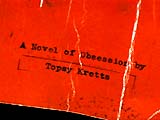 The Number 23: A Novel of Obsession by Topsy Kretts 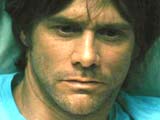 Walter Sparrow (Jim Carrey)  The Murder of Laura Tollins 13 Years Earlier, on her 23rd Birthday 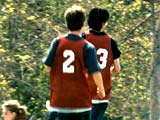 The Number 23 - Seen Everywhere 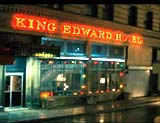 The King Edward Hotel 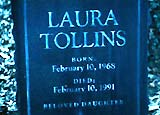 Laura Tollins' Gravesite  Visiting Kyle Flinch in Prison 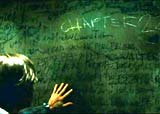 Scrawlings on the Hotel Wall 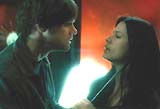 Walter/Fingerling with Agatha/Fabrizia  Feverishly Writing Chapter 23, in Room 23 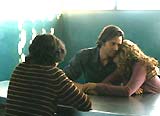 Walter Hospitalized |
||||||||||